Chess is relative limited in the complexity of the rules. Movement in the majority of the chess pieces is very straight forward. There are a couple of special rules that are important in chess and are worth really understanding. Below we will elaborate on these special rules.
Check
Check and checkmate rules are basically warnings that the King is about to be captured. A check means the king is under immediate threat, and the player must respond by taking an action. To bring the King back to safety the player must either move the king, capture the threatening piece, or blocking the threat somehow. With a check there is still an escape possible for the King.
Checkmate
The ultimate goal of chess is to create a checkmate. This occurs when the king is in check but with no possible escape. Once you have achieve a checkmate the game has ended and you have won.
Stalemate
A stalemate is a situation in where the player whose turn it is has no legal moves and their king is not in check. When this happens the game ends immediately in a draw. Despite the number of piece on the table both parties will be awarded with a draw. If you can try to avoid a stalemate unless this is the most positive outcome for yourself.
Pawn promotion
When a pawn reaches the opposite side of the board it can be promoted to any other piece of your choice. Typically people choose a Queen but depending on your situation you can choose the other pieces as well and due consider this. The Queen is not always the best choice. This rule gives pawns the potential to become strategic assets on the board. As they only seem a harmless Pawn in the end they could end up as a Queen. Let’s have a look at this on the board:

In the above board it is the turn of white. White now has the option to move its Pawn on square h8. As a consequence moving the Pawn to that square will immediately allow white to promote the Pawn to a chess piece of its liking.
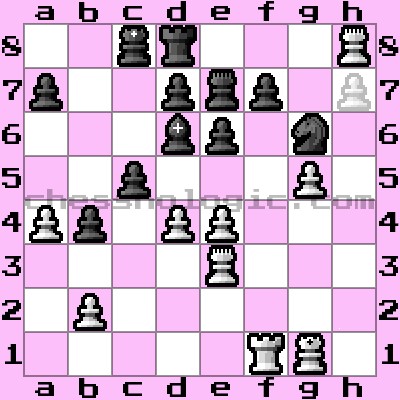
In most cases players will choose the Queen as this is the most versatile chess piece on the board but sometimes it makes sense choose for a different piece for example a Knight due to its unique movement and the ability to jump over other pieces. Just give it a think before you promote a Pawn and understand where this fits into your strategy for that game. This is probably one of the easiest of the special rules in chess to remember but nevertheless one of the strongest.
En passant (capturing on the move by a Pawn)
En passant move allows a pawn to capture an opposing pawn that moves two squares forward from its starting position. The capture must occur immediately after the opponent’s two-square move and happens as if the opponent’s pawn had moved only one square. Let’s see how that looks on the board to clarify.

I have simplified the example her to try to make it as clear as possible. It is the turn of white and decides to do a 2 square move from d2 to d4. The reason why this is allowed is that the white Pawn is still in its starting rank and Pawns are allowed to do a 1 square move or a 2 square move but only from their starting square. So there we go, the move will look like this:

Now it is black’s turn to move. There are a couple of options. Move forward or capture en passant. Black decides to do an en passant move which looks like a standard capture move for a Pawn. That means Black will move his Pawn from e4 to d3.

Although he does not end up in the square of the white Pawn it does count as a capture for Black. This is the en passant rule. It pretty much means you are allowed to capture a oppontents pawn is if they do a 2 square move from their starting position as if you are catching them in their slipstream as they charge over the battlefield.

Now we end up in this position on the board. The black Pawn has captured the white Pawn and lands in square d3 as a consequence.
It is a bit of a weird rule but I suppose it does have reason. Although I am assuming this to be true but in the play if a Pawn makes a 2 square move in theory it would never be able to be captured by other pawns. Not sure if that is the case, if you know the true reason for this rule I would love to hear from you.
This is one of the special rules in chess that you can easily forget. Don’t forget it, it could mean the difference between a win or a lose.
Castling
Castling is the only move in chess where you move two pieces in a single turn. This rule allows the king to move two squares toward a rook and the rook jumps over the king to the square next to it. This is a defensive move that helps protect the king. There are a couple of limitation for castling:
- Neither the King nor the Rook are allowed to have moved before
- No pieces are allowed to stand between the King and the Rook
- The King is not in check and does not move through or into a check position, so not at the final landing square nor in on any of the squares when the King is traveling towards its final destination
Again let’s have a closer look how that looks on the board. In the below text I am describing the white player moves. Black is doing the sames moves for comparison however with other coordinates which are not described:

As said castling is done by moving the King 2 squares towards the Rook. Not more, not less, 2 squares exactly. Let’s do a short castling move first:
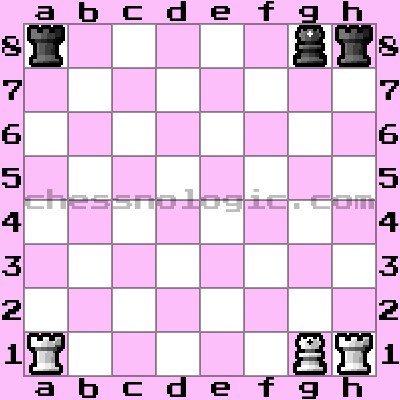
Here the King moves 2 squares from e1 to g1.
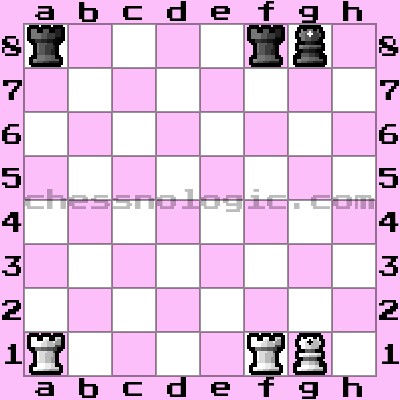
Now the Rook is allowed to “jump” over the King to the square next to the King on the other side. Now let’s do the same for the long castling move.

So again the King must move 2 squares but now to the left from e1 to c1:
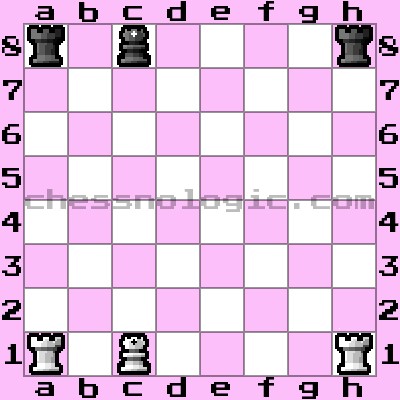
After this again the Rook is allowed to “jump” over the King to land in the sqaure on the right side of the King:
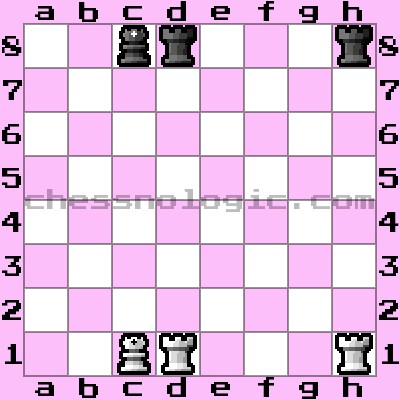
Now the question is why would you want to do this move? Obviously the board never is this empty. Castling is a great way to get your King in safety quickly. If white for example had Pawn on the board they could have acted as a screen for the King as you can see below:
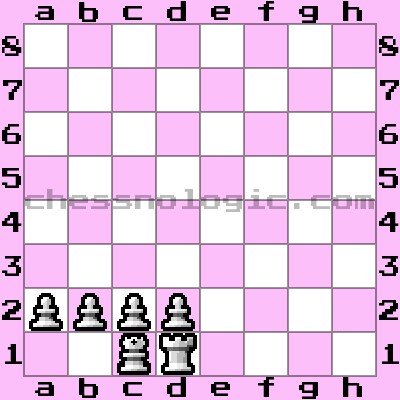
One of the things I wanted to visualize as well is the check positions in movement. So if the King moves on or past a square that could potentially get him in a check position castling is not allowed. Here are 2 examples that can work against you.

In the above scenario white wants to make a castling move from e1 to g1. However the black Bishop can reach square f1. That means if the King would castle to g1 this would trigger a check from the Bishop to the King. Now I realise that the check is not based on the final destination of the King, however these are simply the rules. So therefore a castle move is not allowed to be done to g1 due to the check threat.

Now if there were more pieces on the board the scenario could look like this. Same scenario, same castle move but now under the protection of Pawns. The Bishop lost its check threat however the Knight has a check threat on the final destination of the King on g1. Again the castling to g1 is not allowed and cannot be made by the white player.
Castling is one of the special rules in chess that you need to practice well. It is a very strong defensive move in the game so it is wise to utilize this regularly and early in the game. Next to that it is also important to understand how to deny your opponent a castle move.
The value of the chess pieces
Each piece has a point value that helps players gauge its strength and importance relative to other pieces. These values provide a basic sense of how valuable each piece is in most positions, though the context of the game can affect these numbers. Here’s a breakdown:
- Pawn – 1 point
- Knight – 3 points
- Bishop – 3 points
- Rook – 5 points
- Queen – 9 points
- King – Priceless
These points have no real game value. In a draw they are not used to decide which player was best. What they do help with is evaluating whether a capture and sacrifice was worth it. Furthermore it gives a solid estimate of how strong the combined pieces are of a player and what the chances are to still win.
With these additional special rules you now master all the rules in chess. Without knowing and mastering these rules you will not be able to win or enjoy the game. So well done getting this far and feel free to proceed to the next lesson.
